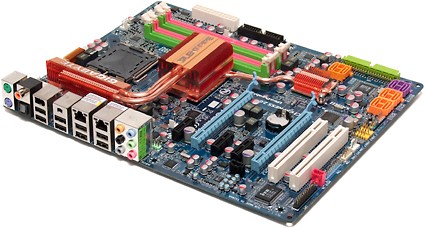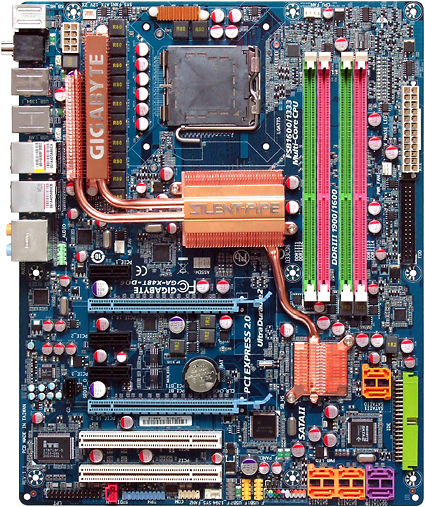X48 Motherboard Comparison
Gigabyte GA-X48T-DQ6
Featuring the same circuit board as the highly-praised GA-X38T-DQ6, Gigabyte's X48T-DQ6 could take overclocking capability one step farther through the X48 Express northbridge's higher-validated FSB stability.
Another thing everyone will notice is that the X48T-DQ6 uses a layout identical in nearly every way to the X48-DQ6, save for its use of DDR3 rather than DDR2 memory.
We could go on about its good slot layout that supports graphics cards coolers up to "triple thick" size, and even mention that the good overall layout is partly due to the fact that the GA-X48T-DQ6 supports only two PCI Express x16 graphics cards (with PCIe 2.0 mode available). Instead of repeating everything, though, we'll just point back to our description of GA-X48-DQ6.
The layout might be the same for the DDR2 and DDR3 models, but the X48T-DQ6 does have a slightly larger northbridge sink. Only Gigabyte knows why the larger sink wasn't used on the DDR2 model, as there appears to be enough space on both versions. The mounting pin locations are further apart on the wider sink, but Gigabyte updated the X48T-DQ6's mounting holes to support it, while leaving the X48-DQ6 with the same mounting pattern as its X38 Express equipped predecessor.
| Gigabyte GA-X48T-DQ6 (Revision 1.1) | |
|---|---|
| Northbridge | Intel X48 Express MCH |
| Southbridge | Intel ICH9R |
| Voltage Regulator | Twelve Phases |
| BIOS | F4d (1/21/2008) |
| 333.3 MHz (FSB1333) | 335.0 MHz (+0.5%) |
| Clock Generator | ICS 9LPRS914EKL |
| Connectors and Interfaces | |
| Onboard | 2x PCIe x163x PCIe x12x PCI2x USB 2.0 (2 ports per connector)1x IEEE-1394 FireWire1x Parallel Port header1x Serial Port header1x Floppy1x Ultra ATA (2 drives)8x Serial ATA 3.0Gb/s1x Front Panel Audio1x CD-Audio In1x S/P-DIF In1x S/P-DIF Out2x Fan 4 pins (CPU/System)3x Fan 3 pins (System/Power) |
| IO panel | 2x PS2 (keyboard + mouse)2x RJ-45 Network8x USB 2.02x IEEE-1394 FireWire2x Digital Audio Out (S/P-DIF optical + coaxial)6x Analog Audio (7.1 Channel + Mic-In + Line-In) |
| Mass Storage Controllers | |
| Intel ICH9R | 6x SATA 3.0 Gb/s (RAID 0,1,5,10) |
| GigaByte SATA2 PCI-E (JMicron) | 1x Ultra ATA-100 (2-drives)2x SATA 3.0 Gb/s (RAID 0,1, JBOD) |
| Network | |
| 2x Realtek RTL8111B PCI-E | 2x Gigabit LAN Connection |
| Audio | |
| HDA (Azalia) Controller Interface | Realtek ALC889A 8 + 2 Channel Codec |
| FireWire | |
| Texas Instruments TSB43AB23 | 3x IEEE-1394a (400 Mbit/s) |
All the interfaces and third-party controllers are shared between the X48T-DQ6 and its DDR2 counterpart, and even the back panel ports are identical. Only the BIOS differs from the X48-DQ6 on the chart above, due to the different memory settings. Once again, we refer you back to the GA-X48-DQ6 for descriptions of each component.
Get Tom's Hardware's best news and in-depth reviews, straight to your inbox.
Current page: Gigabyte GA-X48T-DQ6
Prev Page Additional BIOS Features Next Page BIOS And Overclocking-
Help please.Can this board be configured with the first two (SATA) HDs mirrored and the other drives JBOD? Thank you in advance.Reply
-
oblivionspell Great review, very detailed and informative. But I must say that either you were lucky that your X38 P5E3 Deluxe came with a better-than-average chipset or that I wasn't so lucky and got a malfunctioning one.Reply
I have an Asus Maximus Formula which is, as you know, the Republic of Gamer's solution for the X38 and recently bought a Patriot Extreme Performance 1150mhz PC2-9600. Whenever I try anything above 1020mhz for the RAM my PC reboots; the higher it is the less time it takes to do it. At 1020mhz it'll only reboot if I run something more demanding like 3dMark06 or any new game, at 1100mhz it'll barely show the Windows loading screen then reboot, above 1120mhz it'll not even load windows and freeze. But in every case it boots up fine.
The Asus forums are full of users who can't get stability in any way with >=1066mhz ram on X38 boards. A selected few have come to accomplish it however, which leads me to think those were the lucky ones who got the good shipment, like you. The Patriot forums are the same, X38 users can't get their system stable with RAMS over 1066 or not even that.
Maybe that X48 "official" support is something to consider, it might be the fix to the X38 we users are looking for. Even if it's only to make sure it'll run RAMs at >=1066mhz, it's good enough already.
-
oblivionspell - Have you tried manually setting your RAM voltage to the correct value for the performance setting(s)?Reply
I had to do this on my Asus Crosshair, even though EPP is supposed to take care of it for you. Without manually setting the voltage, I had memory corruption and crashes, but could use the non-EPP mode. With the voltage bumped to the correct 2.1V,
the EPP modes work perfectly. -
Crashman oblivionspellGreat review, very detailed and informative. But I must say that either you were lucky that your X38 P5E3 Deluxe came with a better-than-average chipset or that I wasn't so lucky and got a malfunctioning one.I have an Asus Maximus Formula which is, as you know, the Republic of Gamer's solution for the X38 and recently bought a Patriot Extreme Performance 1150mhz PC2-9600. Whenever I try anything above 1020mhz for the RAM my PC reboots; the higher it is the less time it takes to do it. At 1020mhz it'll only reboot if I run something more demanding like 3dMark06 or any new game, at 1100mhz it'll barely show the Windows loading screen then reboot, above 1120mhz it'll not even load windows and freeze. But in every case it boots up fine.The Asus forums are full of users who can't get stability in any way with >=1066mhz ram on X38 boards. A selected few have come to accomplish it however, which leads me to think those were the lucky ones who got the good shipment, like you. The Patriot forums are the same, X38 users can't get their system stable with RAMS over 1066 or not even that.Maybe that X48 "official" support is something to consider, it might be the fix to the X38 we users are looking for. Even if it's only to make sure it'll run RAMs at >=1066mhz, it's good enough already.Reply
It's just a matter of having the right RAM and using the correct timings and voltage. All X38 and X48 motherboards that support DDR2 memory can run DDR2-1066 speeds with stability, so long as the RAM is set up right in BIOS. -
"Inside, users will find a GUI based on the Smart Common Input Method (SCIM) platform."Reply
This is not accurate. SCIM is an "input method" -- a scheme for entering internationalized text. Not sure what the GUI is really based on. GTK2, maybe? -
Crashman Reply"Inside, users will find a GUI based on the Smart Common Input Method (SCIM) platform."
This is not accurate. SCIM is an "input method" -- a scheme for entering internationalized text. Not sure what the GUI is really based on. GTK2, maybe?
I see your point, but that's the same arguement as "Windows 98SE is a GUI based on DOS". Which is innacurate only in wording. It would be better to say "Windows 98SE is a GUI for DOS".
So, you'd be happier to read "Users will find a GUI for the Smart Common Input Method (SCIM) platform" correct? -
chill70 It's not only the wording. SCIM is not an operating system, so even your example is not analogous (won't even mention that DOS and Windows are separate operating systems with distinct kernels, etc).Reply
This statement is as correct as saying Vista has a GUI based on a 105-key keyboard.
SCIM is an input method platform independent on the GUI. GTK GUI is an widget toolkit, independent on SCIM (although they *may* used each other). Neither is "based" on the other.
If you want to emphasize that the Express Gate supports users of many different languages and nationalities you can mention that the GUI USES SCIM.



